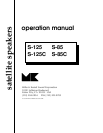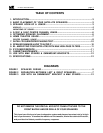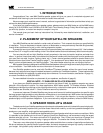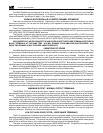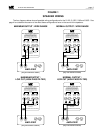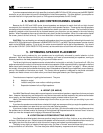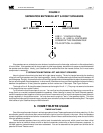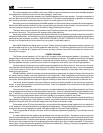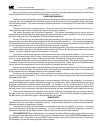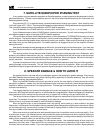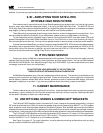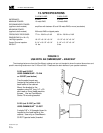
S-125/S-125C/S-85/S-85C page 4
Your M&K Satellites are not designed for bi-wiring. Do not use the four input terminals to bi-wire your Satellites,
as this may damage your amplifier and speakers. If you wish to bi-amplify your Satellites in combination with an M&K
Powered Subwoofer, see Section 9 (page 11) for more details.
HOOKUP (BOTH REGULAR & CENTER CHANNEL SPEAKERS)
There are four terminals on the backplate. Depending on which combination of the four terminals you use to
connect your amplifier, you can alter the tonal quality of your speakers to better match your room, electronics, or
personal preference.
These "Variations of Sound" let you achieve much smoother and flatter frequency response in your room, at your
listening position. See below for a discussion of the MAXIMUM OUTPUT/NORMAL OUTPUT terminals and the LOW
CUT (HIGH PASS FILTER)/WIDE RANGE terminals.
The Positive (+) lead from your amplifier or receiver should be connected to one of the RED (+) INPUT terminals
(either MAXIMUM OUTPUT or NORMAL OUTPUT), and the Negative (-) lead from your amplifier or receiver should
be connected to one BLACK (-) INPUT terminal (LOW CUT [HIGH PASS FILTER] or WIDE RANGE). See Figure 3.
VERY IMPORTANT: NEVER CONNECT THE AMPLIFIER LEADS TO BOTH RED TERMINALS OR TO BOTH
BLACK TERMINALS AT THE SAME TIME. YOU MAY DAMAGE YOUR AMPLIFIER AND SPEAKERS. ANY
RESULTING DAMAGE IS NOT COVERED UNDER WARRANTY.
VARIATIONS OF SOUND
Your M&K Satellites reproduce sound with exceptional transient accuracy and a very wide dynamic range. They
will give you give outstanding results with any high quality amplifier or receiver in virtually any listening environment.
However, getting the best tonal balance in any given room involves many variables. Therefore, your M&K
Satellites allow you to alter their tonal balance in order to get the ideal sound quality at your favorite listening location
(where it counts!), by using one of two combinations of input terminals to connect the speakers to your amplifier.
The terminals are labelled MAXIMUM OUTPUT and NORMAL OUTPUT. Both positions have the same power
handling capacity, but the MAXIMUM OUTPUT position plays the loudest, and works best with low powered amplifiers.
Bear in mind that the MAXIMUM OUTPUT terminal requires a higher setting of the subwoofer level. Conversely,
if you switch to the NORMAL OUTPUT terminal, the subwoofer level should be set lower.
We recommend that you experiment with the terminals, starting out by using the NORMAL OUTPUT and the
WIDE RANGE terminals. If the sound is too dull or boomy-sounding, try switching to the MAXIMUM OUTPUT terminal.
If you have a very large power amp and are hearing distortion or speaker "bottoming" at high volumes, try the LOW CUT
(HIGH PASS FILTER) terminals.
We provide the multiple terminals because we cannot predict in advance exactly what response the speaker will
produce in your room. The choices available through the terminals, however, can allow you to create a virtually ideal
response for your room. Hence, you should use the terminals that best balance the sound for your ears and your room,
so that you get maximum enjoyment from your speakers.
MAXIMUM OUTPUT / NORMAL OUTPUT TERMINALS
The NORMAL OUTPUT terminal gives a warm "musical" sound very similar in character to the finest British-
manufactured monitor speakers, but with a significantly wider dynamic range. Sometimes referred to as the "English
Sound." This should be used in most installations, including mounting on stands, shelves, mounting brackets, etc.
The MAXIMUM OUTPUT terminal gives a bright, forward sound with great efficiency and a wider dynamic range,
with a slightly rising high frequency characteristic. Particularly useful for producing maximum sound power levels,
especially with low-powered amplifiers. Sometimes referred to as the "German Sound." It is particularly useful when
the Satellites are used as surround speakers, as its high frequency contour makes for better highs at the listeners' ears
when the speakers are not directly aimed at the listeners. It also works very well when the speaker is mounted flush
against a large surfaces such as a wall, and sometimes when a Center channel speaker is on top of a large rear-
projection television. As always, we recommend experimentation.
LOW CUT (HIGH PASS FILTER) / WIDE RANGE TERMINALS
The 5 1/4" woofer(s) and 1" tweeter of your Satellites have very high power handling. But it is possible to overdrive
the woofer with deep bass signals, especially when you use a high powered amplifier. This is the reason for the LOW
CUT (HIGH PASS FILTER) terminal. This terminal has a built-in filter that reduces (rolls off) the speaker's bass output
below 80 Hz (at 6 dB per octave), but it does reduce the mid-bass output of the speaker slightly.
Therefore, for most systems, we recommend using the WIDE RANGE terminal. This gives you the natural rolloff
of the speaker and will give you the best sound quality in almost all cases.



